 A new chapter will soon be written in the story of a unique piano with a rich history and even richer legend. This piano has gone by many names — the Piano of Siena, the Harp of David Piano, the King’s Piano — and has been played by some of the greatest pianists in history. The ornately carved wood case is adorned with reliefs of fruits, garlands, urns, birds, cherubs playing instruments standing on the backs of griffins, cherubs in a festive dance, lions, David’s harp, the two tablets of the Ten Commandments and the portraits of illustrious composers Handel, Mozart, Gluck, Luigi Cherubini and the inventor of modern musical notation Guido Aretino.
A new chapter will soon be written in the story of a unique piano with a rich history and even richer legend. This piano has gone by many names — the Piano of Siena, the Harp of David Piano, the King’s Piano — and has been played by some of the greatest pianists in history. The ornately carved wood case is adorned with reliefs of fruits, garlands, urns, birds, cherubs playing instruments standing on the backs of griffins, cherubs in a festive dance, lions, David’s harp, the two tablets of the Ten Commandments and the portraits of illustrious composers Handel, Mozart, Gluck, Luigi Cherubini and the inventor of modern musical notation Guido Aretino.
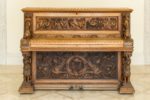 Its visual beauties only added to it celebrity, however. The piano was first created by Turin harpsichord maker Sebastiano Marchisio at the end of the 18th century. His ambition was to create an instrument with the hammered power of the pianoforte, but its harsher sound replaced by the gentle, delicate strains of the harpsichord. A piano that combined these features, Marchisio believed, would do proper justice to the great repertoire of harpsichord music that was increasingly being played on piano alone as the new keyboard instrument eclipsed its ancestor.
Its visual beauties only added to it celebrity, however. The piano was first created by Turin harpsichord maker Sebastiano Marchisio at the end of the 18th century. His ambition was to create an instrument with the hammered power of the pianoforte, but its harsher sound replaced by the gentle, delicate strains of the harpsichord. A piano that combined these features, Marchisio believed, would do proper justice to the great repertoire of harpsichord music that was increasingly being played on piano alone as the new keyboard instrument eclipsed its ancestor.
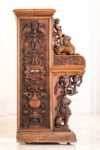 He was only able to complete the resonance box and a full design for the piano before his death. Part of the legend of this instrument is that Sebastiano built the resonance box out of Lebanese cedarwood from two pillars salvaged out of a Sienese church that had been destroyed in an earthquake. The pillars were said to be of the most august lineage: part of the Temple of Solomon that was destroyed by Titus in 70 A.D. He brought the pillars back to Rome as part of his plunder and they were used to construct a pagan shrine. Centuries later, the shrine was destroyed by Christians and a church built in its place reusing Solomon’s pillars. And thus the musical spirit of Solomon’s father, King David, was imbued into the mystical harp-like sound of the piano.
He was only able to complete the resonance box and a full design for the piano before his death. Part of the legend of this instrument is that Sebastiano built the resonance box out of Lebanese cedarwood from two pillars salvaged out of a Sienese church that had been destroyed in an earthquake. The pillars were said to be of the most august lineage: part of the Temple of Solomon that was destroyed by Titus in 70 A.D. He brought the pillars back to Rome as part of his plunder and they were used to construct a pagan shrine. Centuries later, the shrine was destroyed by Christians and a church built in its place reusing Solomon’s pillars. And thus the musical spirit of Solomon’s father, King David, was imbued into the mystical harp-like sound of the piano.
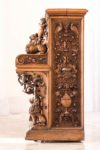 His sons Giacomo and Enrico continued to work on the piano, but they didn’t live to see it completed either. Enrico’s sons Luciano and Rafaello finally finished it as a wedding gift for their sister Rebecca in around 1825. They made changes to Sebastiano’s original design, adding more keys, hammers and strings which, linked to their grandfather’s original soundboard — only 1/5 of an inch thick with four ribs — created a new and distinct sound unlike any other.
His sons Giacomo and Enrico continued to work on the piano, but they didn’t live to see it completed either. Enrico’s sons Luciano and Rafaello finally finished it as a wedding gift for their sister Rebecca in around 1825. They made changes to Sebastiano’s original design, adding more keys, hammers and strings which, linked to their grandfather’s original soundboard — only 1/5 of an inch thick with four ribs — created a new and distinct sound unlike any other.
Rebecca married Antonio Ferri of Siena and moved there with the piano. The piano’s musical virtues made it a local celebrity and it was often played in concerts and at the city cathedral. For such a fine instrument to have such a plain case seemed incongruous to its fans and in the 1850s, Sebastiano’s great-grandson, Rebecca and Antonio’s son, wood-carver Nicodemo Ferri and his cousin Carlo Bartalozzi set about creating a new glamorous exterior better suited to its sublime sound.
The newly fancified Piano of Siena made its international debut at the Exposition Universelle in Paris in 1867 where it was displayed in the Italian pavilion winning several awards. Camille Saint-Saëns, whose fame as a composer and pianist was on the ascendant, played it to great acclaim.
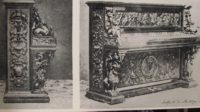 The next year, the city of Siena persuaded Nicodemo Ferri to give the piano to then-Crown Prince Umberto of Savoy as a present for his wedding to his first cousin Princess Margherita of Savoy. And so the piano returned again to Turin, much fancier than when it left, to ascend its own throne. At the presentation of the royal wedding gifts, Franz Liszt himself played La Campanella “until the chandeliers trembled.”
The next year, the city of Siena persuaded Nicodemo Ferri to give the piano to then-Crown Prince Umberto of Savoy as a present for his wedding to his first cousin Princess Margherita of Savoy. And so the piano returned again to Turin, much fancier than when it left, to ascend its own throne. At the presentation of the royal wedding gifts, Franz Liszt himself played La Campanella “until the chandeliers trembled.”
After the last step in the Unification of Italy was achieved when Rome was wrested out of the white-knuckled grasp of the Pope in 1870, the piano was moved to the Quirinal Palace where it remained for 70 years. Maybe. At some point during World War II, it disappeared. Exactly what happened to it is up for debate, but according to its most avid fan, biographer/hagiographer and piano tuner Avner Carmi, it was looted by the Nazis, covered in plaster and buried in the sands of Al Alamein, Egypt.
That’s where it was discovered by British mine sweepers as they swept the site for German bombs planted by Rommel’s retreating troops. They dug up the piano. Nobody thought much of it. It was caked in sand and the plaster coating, which obscured all of the reliefs, prevented it from working. It wound up in the British Salvage Depot in Palestine.
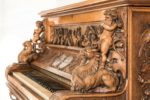 In 1943 it was acquired by a Tel Aviv junk shop dealer, who sold it for a pittance to Avner Carmi’s family. He spent three years and 24 gallons of acetone removing the plaster to reveal the carvings, recognizing it as a fabled piano his grandfather, a famous pianist at the end of the 19th century, had told him about. During the restoration, Carmi made two significant changes: he cut off the front outer arms of the griffins believing their raised position to be uncomfortably close to the Nazi salute, and he removed the wood pull handles on the sides.
In 1943 it was acquired by a Tel Aviv junk shop dealer, who sold it for a pittance to Avner Carmi’s family. He spent three years and 24 gallons of acetone removing the plaster to reveal the carvings, recognizing it as a fabled piano his grandfather, a famous pianist at the end of the 19th century, had told him about. During the restoration, Carmi made two significant changes: he cut off the front outer arms of the griffins believing their raised position to be uncomfortably close to the Nazi salute, and he removed the wood pull handles on the sides.
The newly-restored Siena Piano was played in concerts in Israel and then in 1953 went on tour in the United States. Virtuosos like Arthur Rubinstein and Charles Rosen played the piano and several albums were recorded. Carmi wrote The Immortal Piano, a combination autobiography and piano biography, during his American sojourn. That’s where most of the fanciful stories, like the Solomon pillars in the the earthquake church, come from. He returned to Israel with the piano in 1970.
Anver Carmi died in 1980 leaving the piano to his wife Hannah who refused all offers to buy it. His daughter Smira sold it to a private collector in 1996. It was not seen in public after that, until December 1919 when it appeared, believe it or not, on eBay with a Buy It Now price of $2 million.
Nobody PayPalled anybody two million dollars, I guess, because now it is being offered at auction on Tuesday at Winner’s auction house in Jerusalem. The pre-sale estimate is $1,500,000 – $2,000,000.
There are several YouTube videos online of various pianists playing The Siena. Strange and enchanting but to my ear I don’t think the hybrid nature of the instrument really improves on either straight Harpsichord or Piano renditions.
I have no idea how accurate the various histories are, but it all makes for a wonderful tale :yes:
I’m thinking you mean it appeared on eBay in 2019, not 1919. 😆
I agree that it’s a strange sound. The plunkiness of the piano-ness doesn’t entirely work with the lightness of the harpsichord-ness on every piece I’m finding on Youtube.
But definitely a wonderful story!
https://www.youtube.com/watch?v=Qa-ySUplfNU
I love the sound, actually. Many times I listen to performances that have all the lyrical qualities of a police report, technically perfect without any delicate or expressive interpretation. I think this is wonderful. Thank you for your post. You made my day!
Beautiful carvings.
Why instead of selling it could not be returned to Italian government?
Its place should be the Quirinale once more, it would be visible, and not in a private collection!
The acquisition of Carmi itself is not legitimate after all, since it was stolen by the nazi during WW2, and as his “most avid fan” and great expert himself he supports the thesis that was stolen.
What is the difference in the legitimacy of this acquisition, compared to some other work of art always stolen by the nazis during WW2 and therefore not legit?
I honestly don’t understand..
This is a fascinating story. I agree that it should go back to the Quirinal Palace.
A note: the Temple of Solomon was destroyed in 587 BC (give or take); the Second Temple was destroyed in 70 BC.
I refer you to an interview from February, 2011 in the music magazine/journal FANFARE with the distinguished pianist Jerome Lowenthal, by Robert Schulslaper, entitled “Liszt and Other Legends: A Conversation with Pianist Jerome Lowenthal“. In this interview Lowenthal debunks much of the hallucinatory, fairytale narrative on which Avner Carmi based his book.
Lowenthal was married to Israeli pianist Ronit Amir who was Carmi’s niece; his knowledge concerning the piano is first-hand and intimate. Here are three quotes from the interview:
1- “And the real story of the Siena piano is much more interesting than the fake story, which was done by a ghostwriter”
2- “…there was no Matthew Yanovsky… Avner was an orphan boy who was sent to an orphan asylum and stole food to eat.”
3- “…the piano ruined his life and ruined his family’s life. He could think of nothing else. He left his family, he was completely obsessed and they were very bitter.”